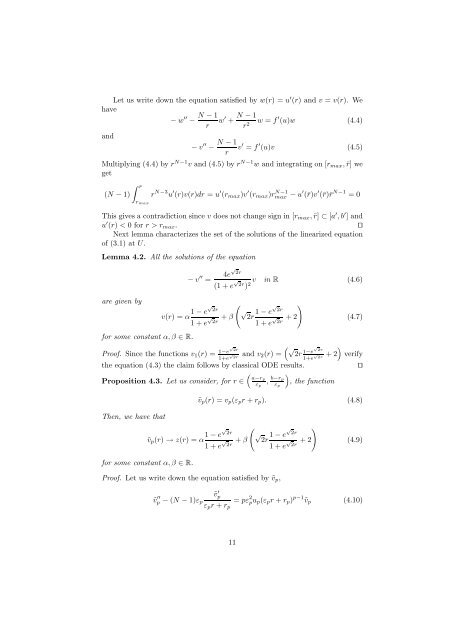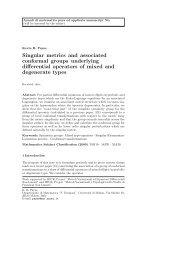Asymptotic behaviour of the Kazdan-Warner solution in the annulus ∗
Asymptotic behaviour of the Kazdan-Warner solution in the annulus ∗
Asymptotic behaviour of the Kazdan-Warner solution in the annulus ∗
You also want an ePaper? Increase the reach of your titles
YUMPU automatically turns print PDFs into web optimized ePapers that Google loves.
Let us write down <strong>the</strong> equation satisfied by w(r) = u ′ (r) and v = v(r). We<br />
have<br />
and<br />
− w ′′ −<br />
N − 1<br />
r w′ N − 1<br />
+<br />
r2 w = f ′ (u)w (4.4)<br />
− v ′′ −<br />
N − 1<br />
v<br />
r<br />
′ = f ′ (u)v (4.5)<br />
Multiply<strong>in</strong>g (4.4) by r N−1 v and (4.5) by r N−1 w and <strong>in</strong>tegrat<strong>in</strong>g on [rmax, ¯r] we<br />
get<br />
¯r<br />
(N − 1)<br />
rmax<br />
r N−3 u ′ (r)v(r)dr = u ′ (rmax)v ′ (rmax)r N−1<br />
max − u ′ (¯r)v ′ (¯r)¯r N−1 = 0<br />
This gives a contradiction s<strong>in</strong>ce v does not change sign <strong>in</strong> [rmax, ¯r] ⊂ [a ′ , b ′ ] and<br />
u ′ (r) < 0 for r > rmax. ⊓⊔<br />
Next lemma characterizes <strong>the</strong> set <strong>of</strong> <strong>the</strong> <strong>solution</strong>s <strong>of</strong> <strong>the</strong> l<strong>in</strong>earized equation<br />
<strong>of</strong> (3.1) at U.<br />
Lemma 4.2. All <strong>the</strong> <strong>solution</strong>s <strong>of</strong> <strong>the</strong> equation<br />
are given by<br />
for some constant α, β ∈ R.<br />
− v ′′ =<br />
4e √ 2r<br />
(1 + e √ 2r ) 2<br />
v(r) = α 1 − e√ 2r<br />
1 + e √ <br />
√2r1 − e<br />
+ β<br />
2r √ 2r<br />
1 + e √ <br />
+ 2<br />
2r<br />
Pro<strong>of</strong>. S<strong>in</strong>ce <strong>the</strong> functions v1(r) = 1−e<br />
√<br />
2r<br />
1+e √ 2r and v2(r) =<br />
v <strong>in</strong> R (4.6)<br />
(4.7)<br />
√ √2r 2r<br />
1−e<br />
1+e √ <br />
+ 2 verify<br />
2r<br />
<strong>the</strong> equation (4.3) <strong>the</strong> claim follows by classical ODE results. ⊓⊔<br />
<br />
a−rp b−rp<br />
Proposition 4.3. Let us consider, for r ∈ , , <strong>the</strong> function<br />
εp εp<br />
Then, we have that<br />
˜vp(r) → z(r) = α 1 − e√ 2r<br />
+ β<br />
for some constant α, β ∈ R.<br />
˜vp(r) = vp(εpr + rp). (4.8)<br />
1 + e √ 2r<br />
√2r 1 − e √ 2r<br />
Pro<strong>of</strong>. Let us write down <strong>the</strong> equation satisfied by ˜vp,<br />
˜v ′ p<br />
1 + e √ 2r<br />
+ 2<br />
˜v ′′<br />
p − (N − 1)εp = pε<br />
εpr + rp<br />
2 pup(εpr + rp) p−1 ˜vp<br />
11<br />
<br />
(4.9)<br />
(4.10)








